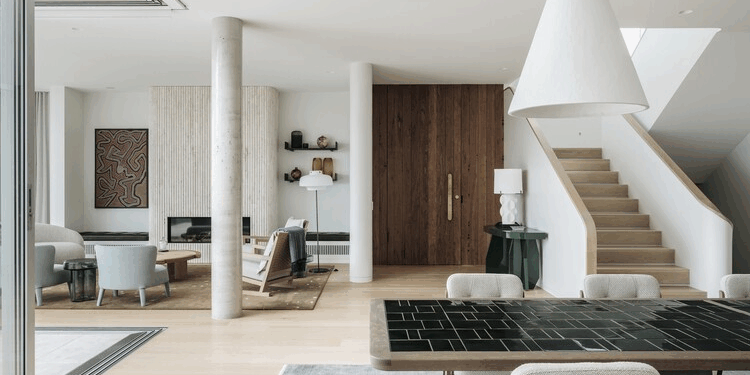
Step into the realm of architectural interior design, where creativity meets functionality in the most captivating way. From the seamless integration of elements to the latest trends shaping the industry, this topic is a fascinating journey through the art of designing breathtaking spaces.
Let's delve deeper into the essence of architectural interior design and uncover the secrets behind creating spaces that not only look stunning but also serve a purpose.
Definition of Architectural Interior Design
Architectural interior design involves the planning, designing, and coordination of interior spaces within architectural structures. It focuses on optimizing the functionality and aesthetics of a space while considering the overall architectural elements and structural integrity.
Importance of Architectural Interior Design
Architectural interior design plays a crucial role in creating spaces that are not only visually appealing but also highly functional. Some key points highlighting its importance include:
- Integration with Architectural Elements: Unlike regular interior design, architectural interior design takes into account the existing architectural features of a space, such as structural columns, beams, and ceiling heights, to create a cohesive design.
- Space Planning and Flow: Architectural interior design focuses on optimizing the layout and flow of a space to ensure efficient use and circulation, considering factors like traffic patterns and functional zones.
- Emphasis on Longevity: By considering the architectural framework of a building, architectural interior design aims to create timeless and enduring designs that complement the overall structure.
Examples of Architectural Interior Design vs. Regular Interior Design
Here are some examples that illustrate the distinctions between architectural interior design and regular interior design:
- Architectural Interior Design:Involves modifying the structural elements of a space, such as removing walls to create an open floor plan or adding architectural details like built-in shelving.
- Regular Interior Design:Focuses on selecting furniture, decor, and color schemes to enhance the aesthetics of a space without altering the underlying architecture.
- Architectural Interior Design:Considers the building's overall design and construction materials to inform material and finish selections that complement the architectural style.
- Regular Interior Design:Primarily concentrates on decorative elements like curtains, rugs, and artwork to personalize and style a space.
Elements of Architectural Interior Design
Interior design is a crucial aspect of creating functional and aesthetically pleasing spaces. Architectural interior design involves various elements that work together to enhance the overall design of a space. Key elements include lighting, color schemes, materials, and furniture. Let's explore how these elements are integrated to create cohesive spaces and the role of architectural features in interior design.
Lighting
Lighting plays a significant role in architectural interior design as it can influence the mood and ambiance of a space. Different types of lighting, such as natural light, ambient lighting, task lighting, and accent lighting, are strategically used to highlight architectural features, create visual interest, and provide functionality.
Color Schemes
Color schemes set the tone and atmosphere of a space. They help create a cohesive look by harmonizing elements within the room. Interior designers carefully select colors based on the desired mood, style, and function of the space. A well-chosen color scheme can make a room feel more spacious, cozy, energetic, or calming.
Materials
The choice of materials in architectural interior design can greatly impact the overall aesthetic and functionality of a space. From flooring materials to wall finishes, furniture, and accessories, each material contributes to the design concept. Designers consider factors like durability, texture, and visual appeal when selecting materials for a space.
Furniture
Furniture plays a crucial role in interior design by providing both functionality and style. The selection of furniture pieces should complement the overall design concept, enhance the flow of the space, and offer comfort to users. The arrangement of furniture also impacts the functionality and visual balance of a room.
Architectural Features
Architectural features such as arches, columns, and beams add character and charm to interior spaces. These elements can define the style of a space, create visual interest, and provide structural support. Interior designers often incorporate architectural features into their designs to enhance the overall aesthetic and create unique focal points within a room.
Principles of Architectural Interior Design
In architectural interior design, several principles play a crucial role in creating visually appealing and functional spaces. These principles include balance, harmony, proportion, and scale. Let's explore how these principles are applied in real-life interior design projects and how they help designers create impactful spaces.
Balance
Balance is essential in architectural interior design as it helps create a sense of equilibrium in a space. There are two types of balance: symmetrical balance and asymmetrical balance. Symmetrical balance involves arranging elements in a space in a mirror-like fashion, while asymmetrical balance involves a more informal and dynamic arrangement of elements that still achieve visual balance.
Harmony
Harmony in interior design refers to the coherence and unity of a space
Proportion
Proportion is the relationship between different elements in a space. It involves ensuring that the size and scale of each element are appropriate relative to each other and the space as a whole. For example, oversized furniture in a small room can throw off the proportion and make the space feel cramped.
Scale
Scale is closely related to proportion but refers specifically to the size of elements in relation to the human body. Designers must consider human scale when designing interior spaces to ensure that furniture and other elements are comfortable and functional for the occupants.By understanding and applying these principles of balance, harmony, proportion, and scale, designers can create interior spaces that not only look visually appealing but also function well and provide a comfortable environment for the occupants.
Trends in Architectural Interior Design
Architectural interior design is an ever-evolving field that constantly adapts to new trends and technologies. In recent years, several key trends have emerged that are shaping the way spaces are designed and experienced. These trends not only influence the aesthetics of interior spaces but also have a significant impact on functionality and sustainability.
Sustainable Design
Sustainable design has become a major focus in architectural interior design, with designers incorporating eco-friendly materials, energy-efficient systems, and sustainable practices into their projects. This trend aims to reduce the environmental impact of interior spaces and create healthier living environments for occupants.
For example, designers are using reclaimed wood, recycled materials, and energy-efficient lighting to create sustainable and visually appealing spaces.
Biophilic Design
Biophilic design is another trend that has gained popularity in recent years, focusing on incorporating nature and natural elements into interior spaces. Designers are integrating elements such as indoor plants, natural light, and organic shapes to create spaces that promote well-being and connection to the natural world.
This trend not only enhances the aesthetics of spaces but also has been shown to improve productivity, mood, and overall health of occupants.
Smart Technology Integration
Smart technology integration is revolutionizing architectural interior design by incorporating advanced technologies into spaces to enhance convenience, comfort, and efficiency. Designers are integrating smart home systems, automated lighting, and climate control systems to create intelligent and responsive environments. This trend not only adds a futuristic element to interior spaces but also improves the overall functionality and user experience.
Importance of Functionality in Architectural Interior Design
Functionality plays a crucial role in architectural interior design as it focuses on creating spaces that are not only visually appealing but also practical and efficient for the occupants. Designers must carefully balance aesthetics with the functionality of a space to ensure that it meets the needs and requirements of the people using it.
Balancing Aesthetics and Functionality
Achieving a successful balance between aesthetics and functionality requires careful planning and consideration. Designers need to understand the purpose of the space, the activities that will take place within it, and the preferences of the occupants. By integrating functional elements seamlessly into the design, designers can enhance the overall user experience while maintaining the visual appeal of the space.
- Utilizing multifunctional furniture pieces that serve dual purposes, such as storage ottomans or convertible sofa beds, to maximize space efficiency.
- Implementing smart storage solutions, such as built-in cabinets or hidden compartments, to declutter the space and improve organization.
- Incorporating flexible layout designs that allow for easy reconfiguration of the space to accommodate different activities or changing needs.
Innovative Design Solutions
Innovative design solutions can enhance both form and function in architectural interiors, creating spaces that are not only visually striking but also highly functional. Designers are constantly pushing the boundaries of traditional design concepts to create innovative solutions that improve the functionality of interior spaces.
- Integrating technology seamlessly into the design, such as smart lighting systems or automated climate control, to enhance the usability and efficiency of the space.
- Using sustainable materials and design techniques to create environmentally friendly spaces that promote health and well-being for the occupants.
- Designing adaptable spaces that can easily transition between different functions, such as a home office that can transform into a guest bedroom when needed.
Epilogue
As we conclude our exploration of architectural interior design, it's clear that the intersection of aesthetics and practicality is where true magic happens. The ability to transform ordinary spaces into extraordinary masterpieces is a testament to the power of thoughtful design.
Query Resolution
What sets architectural interior design apart from regular interior design?
Architectural interior design focuses not only on aesthetics but also on the structural elements of a space, such as beams, columns, and arches, to create a cohesive design that enhances functionality.
How do principles like balance and proportion play a role in architectural interior design?
Balance and proportion are essential in creating harmonious spaces that feel visually pleasing and well-designed. These principles guide designers in achieving a sense of equilibrium in their projects.
What are some current trends influencing architectural interior design?
Current trends include sustainable design practices, biophilic design elements that bring nature indoors, and the integration of smart technologies to enhance the functionality of spaces.













